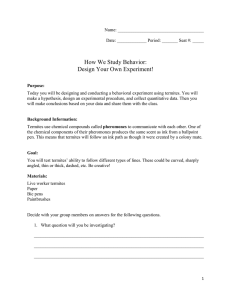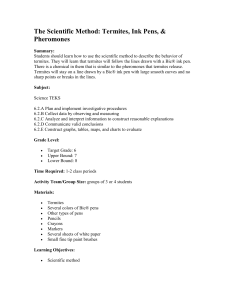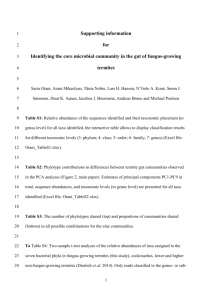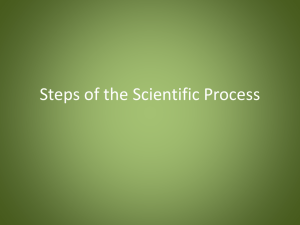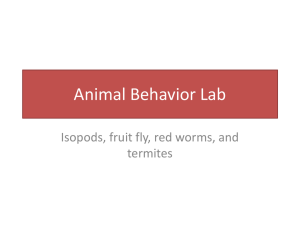Steps of the scientific method
advertisement
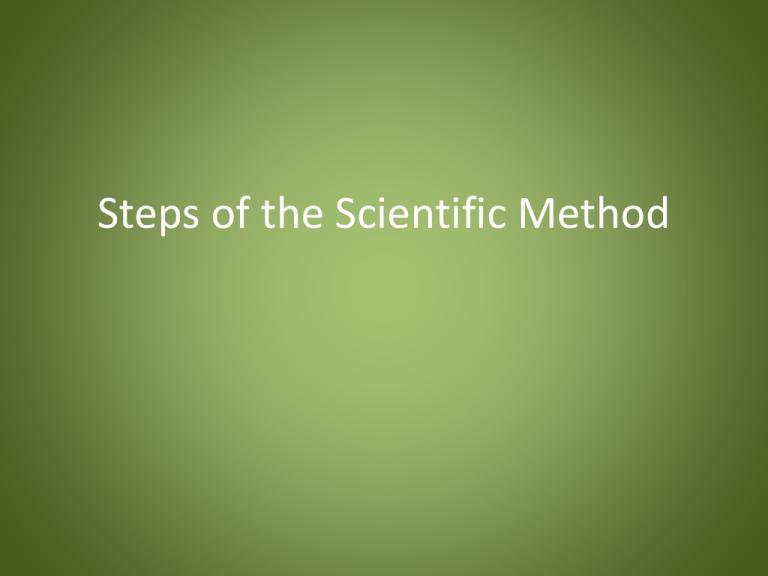
Steps of the Scientific Method Introduction to the Scientific Method • A logical, problem solving technique Introduction to the Scientific Method Identify a problem Gather Information Formulate a hypothesis Analyze Data Record and Organize Data Design and Experiment Draw Conclusions Use conclusions to develop a new hypothesis Step 1: Identify a Problem • Observe the world around you • Using observations, identify a problem you would like to solve • Example: Why do termites follow the ink line? • This is a question you DO NOT know the answer to and can’t look up. • “Why” and “What would happen if..” are good beginnings of scientific questions. Remember? Observation • Uses our senses to gather information • Qualitative: uses our 5 senses – The termites follow a circle made with a blue pen on white paper Inference • A logical interpretation of events based on prior knowledge or opinion – Educated guess • Termites follow the blue line because they like it. • Quantitative: uses numbers – 3 termites follow a circular blue pen line that is 5 cm in diameter Do we use observations or inferences when identifying a problem? Step 2: Gather Information • Use references to do background research – – – – – – – Books Journals Magazines Internet TV Videos Interview Experts • Example: Termites – Live underground – Don’t have compound eyes (can only see light and dark) www.goldstarexterminators.net Step 3: Formulate a Hypothesis Hypothesis • Possible answer to a question that can be tested • based on observations and knowledge • “If” “Then” “Because” statement Example: Termites • Termites: – I hypothesis that if the termites follow a dark colored pen on a dark background then they follow the dark pen on a light background because of the color contrast since they see light and dark, but not color. Do we use observation or inference to formulate a hypothesis? Step 4: Develop an Experiment Materials: • A list of all the things you need • Supplies Procedure • Step by step instructions • Identifies the variables used in the experiment How would you describe how to make a Peanut Butter and Jelly Sandwich to someone who had never done it? To someone who didn’t know what peanut butter or jelly is? Variables: Independent Variable • The variable I (the scientist) change or manipulate • Examples: – The color of paper under the termites – The color of pen used – The brand of pen used Variables: Dependent Variable • Is measured in the experiment • Changes because of the independent variable • “Depends” on the independent variable • Examples: – Does the termite follow the line (yes/no) – How many termites follow the line (whole number) – How long do the termites follow the line (time) Constants • All the factors in the experiments that are kept the same • Everything except the independent variable • Keeps the experiment ‘fair’ Examples: • If you test color of paper, keep the color of pen constant • If you test the smell of pen, keep the color and type of pen constant (only change smell) • The exact termites used • The time of day and how long the termites are there • The shape of the line drawn Controls • The normal condition that you compare the other conditions to • Recreate the conditions you first observed • Example: – Termites in a Pitri dish on white filter paper and draw a blue line with a bic pen in the same shape as before. Step 5: Record and Organize Data • Write all observations and measurements • Use a table to organize your data – List your independent variable on the left side – Record your dependent variables on the right side • If you have more than one dependent variable, use a new column for each dependent variable Independent Variable Dependent Variable: Did they follow the line? Blue ink on white paper Yes/No Blue ink on black paper Yes/No Which one of these independent variables is the control? Which part of the independent variable is the constant? Step 6: Analyze Data • “A picture is worth a thousand words” • Compare and look for trends and patterns using graphs Bar Graph Number of Termites Used for categorical data Line Graph Number of Termites Number of termites on the ink line for 40 seconds Line graphs are used for time interval data Pie Chart A Pie Chart adds up to a whole – 100% or all of something Step 7: Make Conclusions • You must repeat the experiment to make the data valid • You should run your experiment at least 3 times to confirm your results – You can run all the experiments at one time, or run one after the other • Each separate experiment is called a Repetition (or Rep). Experimental Error occurs when something goes wrong in an experiment and the scientist cannot reach a valid conclusion can be caused when the scientist makes a mistake ex: measuring incorrectly or leaving out a step of the experiment can be caused by the independent variable or by something the scientist tried to control
